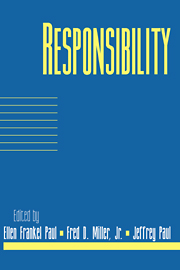Book contents
- Frontmatter
- Contents
- Introduction
- Acknowledgments
- Contributors
- Causation and Responsibility
- Negligence
- Responsibility and Consent: The Libertarian's Problems with Freedom of Contract
- The Irrelevance of Responsibility
- On Responsibility in Science and Law
- Responsibility and the Abuse Excuse
- Why Citizens Should Vote: A Causal Responsibility Approach
- Institutionally Divided Moral Responsibility
- Fate, Fatalism, and Agency in Stoicism
- Ultimate Responsibility and Dumb Luck
- Taking Responsibility for Our Emotions
- Index
Causation and Responsibility
Published online by Cambridge University Press: 06 January 2010
- Frontmatter
- Contents
- Introduction
- Acknowledgments
- Contributors
- Causation and Responsibility
- Negligence
- Responsibility and Consent: The Libertarian's Problems with Freedom of Contract
- The Irrelevance of Responsibility
- On Responsibility in Science and Law
- Responsibility and the Abuse Excuse
- Why Citizens Should Vote: A Causal Responsibility Approach
- Institutionally Divided Moral Responsibility
- Fate, Fatalism, and Agency in Stoicism
- Ultimate Responsibility and Dumb Luck
- Taking Responsibility for Our Emotions
- Index
Summary
introduction: liability, responsibility, and metaphysics
In various areas of Anglo-American law, legal liability turns on causation. In torts and contracts, we are each liable only for those harms we have caused by the actions that breach our legal duties. Such doctrines explicitly make causation an element of liability. In criminal law, sometimes the causal element for liability is equally explicit, as when a statute makes punishable any act that has “caused… abuse to the child….” More often, the causal element in criminal liability is more implicit, as when criminal statutes prohibit killings, maimings, rapings, burnings, etc. Such causally complex action verbs are correctly applied only to defendants who have caused death, caused disfigurement, caused penetration, caused fire damage, etc.
One might think that the simple fact that these causation-drenched legal texts exist is enough to justify judges and legal theorists in taking an immediate leap into the scientific and philosophical theories of causation. Such a leap would be based on the supposition that when a legal text uses a word from science and everyday life like “cause,” it must then mean for the word to be interpreted in its ordinary or scientific sense. Such a supposition is belied by the practice of most lawyers and legal theorists.
- Type
- Chapter
- Information
- Responsibility , pp. 1 - 51Publisher: Cambridge University PressPrint publication year: 1999
- 5
- Cited by

